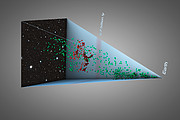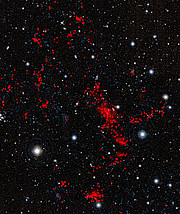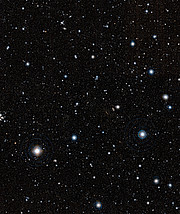Press Release
Shedding Light on the Cosmic Skeleton
3 November 2009
Astronomers have tracked down a gigantic, previously unknown assembly of galaxies located almost seven billion light-years away from us. The discovery, made possible by combining two of the most powerful ground-based telescopes in the world, is the first observation of such a prominent galaxy structure in the distant Universe, providing further insight into the cosmic web and how it formed.
“Matter is not distributed uniformly in the Universe,” says Masayuki Tanaka from ESO, who led the new study. “In our cosmic vicinity, stars form in galaxies and galaxies usually form groups and clusters of galaxies. The most widely accepted cosmological theories predict that matter also clumps on a larger scale in the so-called ‘cosmic web’, in which galaxies, embedded in filaments stretching between voids, create a gigantic wispy structure.”
These filaments are millions of light years long and constitute the skeleton of the Universe: galaxies gather around them, and immense galaxy clusters form at their intersections, lurking like giant spiders waiting for more matter to digest. Scientists are struggling to determine how they swirl into existence. Although massive filamentary structures have been often observed at relatively small distances from us, solid proof of their existence in the more distant Universe has been lacking until now.
The team led by Tanaka discovered a large structure around a distant cluster of galaxies in images they obtained earlier. They have now used two major ground-based telescopes to study this structure in greater detail, measuring the distances from Earth of over 150 galaxies, and, hence, obtaining a three-dimensional view of the structure. The spectroscopic observations were performed using the VIMOS instrument on ESO’s Very Large Telescope and FOCAS on the Subaru Telescope, operated by the National Astronomical Observatory of Japan.
Thanks to these and other observations, the astronomers were able to make a real demographic study of this structure, and have identified several groups of galaxies surrounding the main galaxy cluster. They could distinguish tens of such clumps, each typically ten times as massive as our own Milky Way galaxy — and some as much as a thousand times more massive — while they estimate that the mass of the cluster amounts to at least ten thousand times the mass of the Milky Way. Some of the clumps are feeling the fatal gravitational pull of the cluster, and will eventually fall into it.
“This is the first time that we have observed such a rich and prominent structure in the distant Universe,” says Tanaka. “We can now move from demography to sociology and study how the properties of galaxies depend on their environment, at a time when the Universe was only two thirds of its present age.”
The filament is located about 6.7 billion light-years away from us and extends over at least 60 million light-years. The newly uncovered structure does probably extend further, beyond the field probed by the team, and hence future observations have already been planned to obtain a definite measure of its size.
More information
This research was presented in a paper published as a letter in the Astronomy & Astrophysics Journal: The spectroscopically confirmed huge cosmic structure at z = 0.55, by Tanaka et al.
The team is composed of Masayuki Tanaka (ESO), Alexis Finoguenov (Max-Planck-Institute for Extraterrestrial Physics, Garching, Germany and University of Maryland, Baltimore, USA), Tadayuki Kodama (National Astronomical Observatory of Japan, Tokyo, Japan), Yusei Koyama (Department of Astronomy, University of Tokyo, Japan), Ben Maughan (H.H. Wills Physics Laboratory, University of Bristol, UK) and Fumiaki Nakata (Subaru Telescope, National Astronomical Observatory of Japan).
ESO, the European Southern Observatory, is the foremost intergovernmental astronomy organisation in Europe and the world’s most productive astronomical observatory. It is supported by 14 countries: Austria, Belgium, Czechia, Denmark, France, Finland, Germany, Italy, the Netherlands, Portugal, Spain, Sweden, Switzerland and the United Kingdom. ESO carries out an ambitious programme focused on the design, construction and operation of powerful ground-based observing facilities enabling astronomers to make important scientific discoveries. ESO also plays a leading role in promoting and organising cooperation in astronomical research. ESO operates three unique world-class observing sites in Chile: La Silla, Paranal and Chajnantor. At Paranal, ESO operates the Very Large Telescope, the world’s most advanced visible-light astronomical observatory. ESO is the European partner of a revolutionary astronomical telescope ALMA, the largest astronomical project in existence. ESO is currently planning a 42-metre European Extremely Large optical/near-infrared Telescope, the E-ELT, which will become “the world’s biggest eye on the sky”.
Links
Contacts
Masayuki Tanaka
ESO
Garching, Germany
Tel: +49 89 3200 6498
Email: mtanaka@eso.org
About the Release
| Release No.: | eso0941 |
| Legacy ID: | PR 41/09 |
| Name: | Galaxy, Universe |
| Type: | Early Universe : Cosmology : Morphology : Large-Scale Structure |
| Facility: | Subaru Telescope, Very Large Telescope |
| Instruments: | VIMOS |
| Science data: | 2009A&A...505L...9T |





